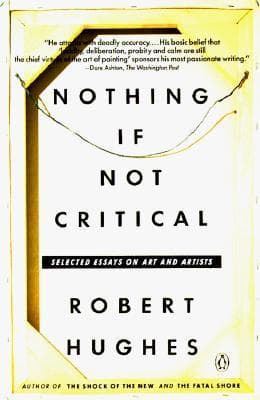
Book Review Summary: Nothing If Not Critical: Selected Essays on Art and Artists
Introduction
"Nothing If Not Critical: Selected Essays on Art and Artists" by Robert Hughes is a collection of essays that delves into the world of art and artists from the past to the present. As one of the most controversial art critics in America, Hughes brings his wit and authority to bear on a wide range of subjects, evoking the essences, works, and worlds of various artists. In this book review, we will explore the author's background, analyze common opinions among readers, and discuss why this book is recommended or not recommended.
About Robert Hughes
Robert Hughes, born in Australia, is an art critic, writer, and television documentary maker who has resided in New York since 1970. He has a background in arts and architecture and is known for his influential art criticism. Hughes has written extensively on art history, including the bestselling books "The Fatal Shore" and "The Shock of the New." He has also provided commentary on the works of artists such as Robert Crumb and Jeff Koons. Hughes's ability to balance historical context, biographical information, and astute observations in his critiques has earned him a reputation as a skilled art critic.
Analysis of Views
- Historical Context: Many readers appreciate Hughes's emphasis on the importance of historical context in understanding art. He argues that great art is built on history rather than trying to tear it down, which leads to a pessimistic outlook on the future of art. The decline of art education, an ahistorical attitude among artists, and the absurd consumerism of the art market are seen as major factors contributing to this pessimism.
- Artistic Freedom: Hughes's views on artistic freedom are a point of contention among readers. While some agree with his assessment that without a framework, artistic freedom tends to degenerate into chaos, others find his outlook pessimistic. The optimistic viewpoint that a new pluralism has swept into the art world and artists have an unprecedented level of freedom is contrasted with Hughes's belief that history provides a necessary framework for artistic expression.
- Critiques of Art Shows: The majority of the book consists of reviews of art shows that Hughes published in Time magazine in the early-to-mid 80s. Readers appreciate his style of criticism, which finds a balance between historical context, biographical information, and astute observations in front of the work itself. Hughes's critiques are praised for their insightfulness and ability to convey the essence of an artist's work.
- Bias and Personal Opinion: Some readers feel that Hughes's occasional bias is evident in his critiques. While he frequently has incredible insight into artists, movements, and art markets, his occasional pompousness is easy to forgive because of his love for art and his ability to cut through any hype to get to the core of an artist's integrity and ability. However, some readers find his personal opinions overshadowing his critical analysis at times.
- Art Market and Commercialization: Hughes's critiques often touch on the art market and commercialization of art. Readers appreciate his ability to dissect the complexities of the art market and expose its flaws while still recognizing the positive aspects of art as a means of financial gain. His critique of the 1980s art market is seen as particularly relevant to contemporary discussions about the role of money in the art world.
Reasons for Recommendation
- Insightful Criticism: Readers recommend "Nothing If Not Critical" for its insightful criticism of art shows and artists from various periods and locations. Hughes's sharp analysis and concise writing style make it easy to understand his perspective on each artist's work. His essays provide valuable insights into the artists' inspiration, influence, and oeuvre, making it a valuable resource for art enthusiasts.
- Historical Context: The book's emphasis on historical context is seen as a strength by many readers. Hughes's ability to place artists within their historical context helps readers understand their works better and appreciate their contributions to the art world. This historical perspective adds depth to his critiques and makes them more meaningful for those interested in art history.
- Wit and Humor: Hughes's wit and humor are highly appreciated by readers. His sharp turns of phrase and ability to lampoon pretentiousness in the art world add levity to his critiques while still maintaining their critical edge. His humor makes reading about art more enjoyable and accessible to a wider audience.
Reasons for Not Recommendation
- Outdated Content: Some readers feel that the book's content is somewhat outdated due to its focus on art shows from the 1980s. While Hughes's insights are still valuable, readers who are looking for more contemporary critiques may find this aspect limiting. Additionally, some readers feel that certain artists or shows covered in the book are not relevant or impactful enough to warrant inclusion in such a collection.
- Repetitive Sentences: While Hughes's writing style is generally praised for its vigor and insightfulness, some readers find his sentences to be repetitive at times. They feel that his sentences run on too much and detract from the overall flow of his critiques. This repetition may be particularly noticeable for those who are not familiar with the artists he is discussing or who do not share his level of expertise in art history.
Conclusion
"Nothing If Not Critical: Selected Essays on Art and Artists" by Robert Hughes offers readers a unique perspective on art history and contemporary artists through its insightful critiques and historical contextualization. While some readers appreciate Hughes's sharp analysis and wit, others find his occasional bias and repetitive writing style limiting. Overall, this book serves as a valuable resource for those interested in exploring the world of art through the eyes of one of America's most controversial art critics.